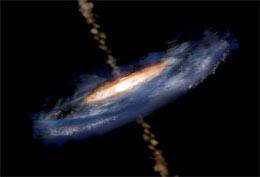
|
| ©NASA/ Aurore Simonnet, Sonoma State University |
| The source of high-energy rays, or not? |
High-energy cosmic rays might not be from active galactic nuclei after all.
The origin of ultra-high-energy cosmic rays is one of the great mysteries of cosmology. Last week a team reported that they thought they had tracked down the source. But the first check on that answer, by another team with different data, has failed to support it.
The latest work has not yet been published, so it is hard for the community to know what to make of the results. But the conclusion hints that the mystery of high-energy cosmic rays remains open. "This whole field is a minefield," says Trevor Weekes, a cosmic-ray researcher with the Harvard-Smithsonian Center for Astrophysics in Cambridge, Massachusetts. "Cosmic rays have caused a lot of false alarms in the past."
An international collaboration of more than 370 scientists working at the Pierre Auger Observatory in Argentina, reported last week that the rare ultra-high-energy cosmic rays come from active galactic nuclei (see High-energy cosmic rays traced to source). These violent galaxies have supermassive black holes at their centre, and had been touted as, but never proven to be, the source of cosmic rays some 100 million times more energetic than those produced by Earth's best particle accelerators. The rays have energies of up to 100 x 1018 electronvolts.
The announcement caused a lot of excitement in the community, although everyone, including the team, cautioned that it was only a correlation rather than a proof. The Auger team had looked independently at two sets of cosmic-ray data from events in the southern hemisphere, and tried to trace them back to their source. Twelve of 15 events in the first set, and 8 of 13 in the second, could be traced back to active galactic nuclei within 250 million light years of Earth, with the course of the rays bent by less than 3.1 degrees by galactic magnetic fields.
Now, the High Resolution Fly's Eye (HiRes) collaboration, a smaller operation based at the University of Utah in Salt Lake City, has tried to check this conclusion against data from ultra-high-energy cosmic-ray events they detected in the northern sky. The researchers used the Auger team's parameters for factors such as the maximum distance of the active galactic nuclei from Earth and the maximum angle the ray will be bent by interactions with magnetic fields, and looked to see whether the active galactic nuclei could also explain their events. Their results suggest that they don't.
"They see correlations, we do not see correlations," says Gordon Thomson, one of the HiRes collaborators. Only 2 of the 13 events looked at by the HiRes team correlated with active galactic nuclei.
Uncertain times
Paul Mantsch, a member of the Auger team based at Fermilab in Batavia, Illinois, points out that the two teams have different estimates for the energy of the rays, which might cause problems in comparing the results. The Auger team saw correlations with active galactic nuclei only for very-high-energy rays, he says. If HiRes looks only at their own highest-energy rays, he says, there could be so few events as to make "statistical conclusions even more difficult".
Without seeing all the data and calculations, "it is very hard for members of the Auger Collaboration to comment helpfully", says Auger spokesman Alan Watson, from the University of Leeds, UK.
The paper itself may not be written up for a few weeks yet, the HiRes team says.
Andrea Santangelo, from the University of Tübingen in Germany, who is a member of the Extreme Universe Space Observatory mission team, which aims to look at high energy cosmic rays from space, says that more data will help to settle the issue. Within a year Auger will have twice as many data, and Santangelo says he expects this to again confirm its initial results.
But Thomson adds there is another problem: no one understands how active galactic nuclei, or indeed any known phenomena, makes these rays. "You can't show in a convincing way that these objects can accelerate these cosmic rays to the energies we see," he says. It might be that they sit next to some as-yet-unknown object that produces the rays, he says.
If it's not active galactic nuclei, says Weekes, "we have no idea" what the source is.



Reader Comments
to our Newsletter